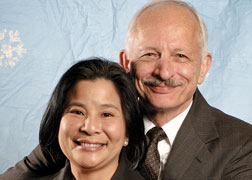Reunion memories lead to medical education gift
When it comes to using technology in a medical setting, Dr. Robert E. Hoyt (M.D. ’71; H.S. ’74) literally wrote the book on the subject. He and his wife, Dr. Ann Yoshihashi, along with associate editor Nora Bailey, are the authors of a widely used text on health informatics, now in its fifth edition.
The use of information technology provides many benefits for patients and physicians alike, from telemedicine scenarios to tracking the use of multiple prescriptions, but it’s not the only ingredient. The human element, Hoyt explained, is essential to medical care.
“I’m something of a unique duck,” he said. “While I currently teach cutting-edge technology in health informatics, I still have one foot in the best of the old tradition. When I was in practice, I made lots of house calls and lectured on the importance of patient interaction.”
As director of the medical informatics program in the School of Allied Health and Life Sciences at University of West Florida in Pensacola, Fla., Hoyt is quick to apply his clinical experience in the classroom setting.
“Young physicians don’t understand the continuity of care and the powerful position they’re in to help people in all kinds of trouble,” he said. “It goes further than advising people about treatment.”
Providing clinical experience for medical students is one of the reasons he and his wife made a $150,000 gift to support the creation of a simulation center in the Virginia Commonwealth University School of Medicine’s new education building. This most recent generosity is in addition to a class scholarship gift made in honor of Hoyt’s 40th reunion.
“It was the 2011 reunion that stimulated the idea,” he said. “Being with classmates and sharing fond memories made me think. My wife and I are in the position to give back. It’s a golden opportunity to positively influence physicians of the future. There’s value in both technology and the development of the bedside manner. I don’t put one above the other. We need to embrace the newest technology but not forget about the doctor-patient relationship. We have to be big patient advocates.”
Future students will develop and hone their clinical skills in the simulation center in the 200,000-square-foot facility, which is expected to be complete in spring 2013. Two floors will be dedicated to the simulation center, which uses high-tech advances to create a low-risk setting for students to gain clinical experience.
“It’s fitting that the debriefing room in the building’s simulation center will carry Bob and Ann’s names,” said Dr. Jerome F. Strauss III, dean of the School of Medicine, and executive vice president for medical affairs at VCU Health System. “That’s the place where students review their handling of the different patient-care scenarios with their mentors and, in doing so, transform what could be just an educational exercise into clinical wisdom. That kind of dialogue and application of technology typifies what Bob and Ann have worked toward over their own careers. We are very grateful to have their support of the medical school’s campaign.”
To learn more about the School of Medicine’s new medical education center, contact Tom Holland, associate dean for development, at (804) 828-4800 or teholland@vcu.edu.
